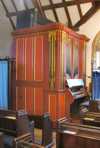For this church:    |
Bleasby St MaryOrgan
The organ is self-contained within a panelled casing painted red with gold mouldings decorating the panels of the frame. Highly decorated organ pipes are set over the console and on the front corners of the casing. Originally hand pumped it now has as electric blower, but the old pumping handle remains in place firmly locked but visible on the side of the casing. The instrument was originally built in 1783 for the grandfather of the Rev Mr Marsh (vicar 1848-74). Its first home was Nethersole House near Canterbury. It was moved around the country five times before being installed in St Mary’s Bleasby in 1848, the year Mr Marsh moved to the parish. The National Pipe Organ Register names the original builder as Joseph Walker and classes it as a “barrel organ” Their records also show that it was built for the private residence of the Marsh family but later moved to the church of St Peter and St Paul Aylesford, Kent with a further move to Bleasby in 1838 by the organ builders Gray and Davidson, 370 Euston Road London. Gray and Davidson also took the organ down and re-sited it. The final move was probably part of the 1869 church extensions by Ewan Christian, his plan of that date shows the organ in its present position. The 1838 date could simply be a recording error. Currently the organ is maintained by Cowans Organs of Leicester. |






